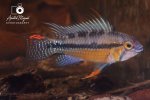Rio
New Member
- Messages
- 9
- Location
- Wageningen, Gelderland
Not so long ago I bought a male and female wild Apistogramma cacatuoides from a good not so lfs for my "Quebrada Nauta (Rio Itaya)-biotope". The fish where so stressed in the shop that I just did not recognize them as A. cacatuoides and I walked right by them. After checking out the entire store I asked an employee where they kept the wildcaught A. cacatuoides and she lead me to a tank full of pale apisto's covered in black spots from the black spot disease/parasite. So they are definitely wild fish. She took her time to catch me a nice male that was comfortable enough to show some color and a female. Back home it turned out I probably got the least spotted fish in the entire tank as only very few black spots are visible. So I got lucky, or not, the spots make them look truely wild, so it would be fitting for a biotope tank.
Since my biotope tank is far from finished I put them in a 80 x 40 x 35 cm tank with 15 Hemigrammus hyanuary. They quickly colored up and showed what to me seemed normal cacatuoides colors. Once they started breeding something strange happend to the colors of the female, I am used to caca's having a stripe down the body when i breeding mode, but this female only shows a spot. So I really doubt they are real A. cacatuoides.
What I know so far, is that they are wild and the shop tells me they are from Peru. The first picture shows the female before breeding, the second and third while breeding.



the next two pictures are of the male.


and some picture of the babies the first picture is the sole survivour of the first nest, the second picture show some of the second nest.


Any help in identifying these fish would be very much appreciated. If more pics are needed let me know. I have some more and could always try to make some more. Although my camera is not the best, nor are my fish photography skills.
Since my biotope tank is far from finished I put them in a 80 x 40 x 35 cm tank with 15 Hemigrammus hyanuary. They quickly colored up and showed what to me seemed normal cacatuoides colors. Once they started breeding something strange happend to the colors of the female, I am used to caca's having a stripe down the body when i breeding mode, but this female only shows a spot. So I really doubt they are real A. cacatuoides.
What I know so far, is that they are wild and the shop tells me they are from Peru. The first picture shows the female before breeding, the second and third while breeding.
the next two pictures are of the male.
and some picture of the babies the first picture is the sole survivour of the first nest, the second picture show some of the second nest.
Any help in identifying these fish would be very much appreciated. If more pics are needed let me know. I have some more and could always try to make some more. Although my camera is not the best, nor are my fish photography skills.






